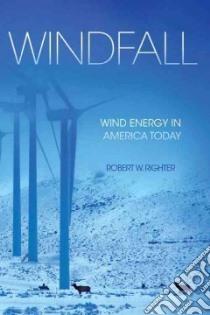Windfall - 9780806141923
Un libro in lingua di Righter Robert W. edito da Univ of Oklahoma Pr, 2011
- € 16.60
- Il prezzo è variabile in funzione del cambio della valuta d’origine
Not long ago, energy experts dismissed wind power as unreliable and capricious. Not anymore. The industry has arrived, and the spinning blades of this new kid on the electric power block offer hope for a partial solution to our energy problems by converting nature's energy into electricity without exposing our planet and its inhabitants to the dangers of heat, pollution, toxicity, or depletion of irreplaceable natural resources. Windfall tells the story of this extraordinary transformation and examines the arguments both for and against wind generation.
In Windfall, Robert W. Righter explains how wind is transformed into energy and examines the land-use decisions that affect the establishment of new wind farms. The book also discusses the role of tax credits and other government subsidies in the creation of transmission systems between the turbines and end users in cities.
Currently the world's fastest-growing source of energy, wind generation has also given rise to backlash. A critical advocate of wind energy whose career as a historian has focused on environmental controversies, Righter addresses the cultural dimensions of resistance to wind energy and makes considered predictions about the directions wind energy may take. His sympathetic treatment of opposing arguments regarding landscape change, unwanted noise, bird deaths, and human medical implications are thought-provoking, as is his recommendation that we place the lion's share of turbines on the Great Plains.
Most books on wind energy are technical manuals. Righter's book does not shy away from scientific explanations, but he does not write for engineers. His broad, historically informed vision will appeal to policy makers at the federal, state, and local levels and to anyone interested in a technology increasingly significant to supplying America's energy needs.
Informazioni bibliografiche
- Titolo del Libro in lingua: Windfall
- Sottotitolo: Wind Energy in America Today
- Lingua: English
- Autore: Righter Robert W.
- Editore: Univ of Oklahoma Pr
- Collana: Univ of Oklahoma Pr (Paperback)
- Data di Pubblicazione: 01 Settembre '11
- Genere: TECHNOLOGY and ENGINEERING
- Argomenti : Wind power United States Wind turbines Environmental aspects United States Electric power production United States
- Pagine: 219
- EAN-13: 9780806141923


